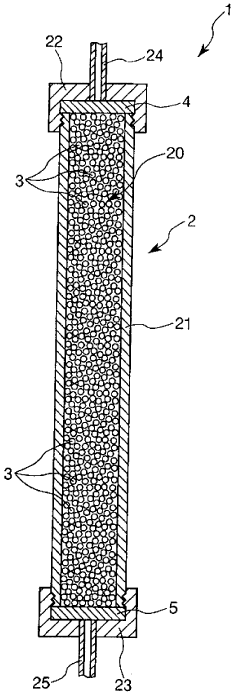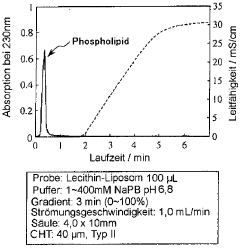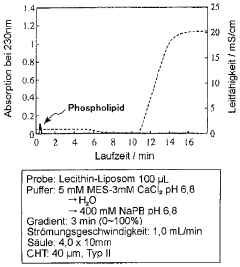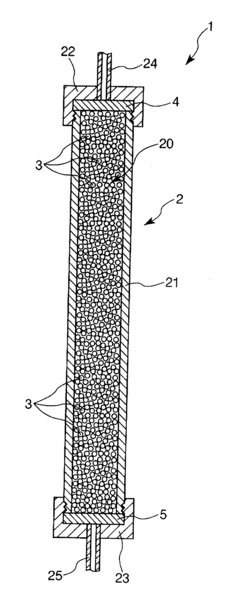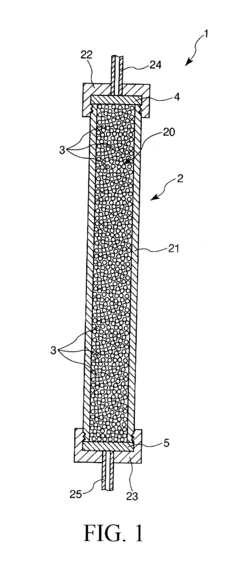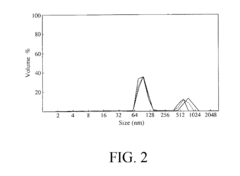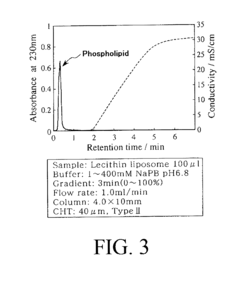How to Analyze Phospholipid Aggregation in Solution?
JUL 16, 20259 MIN READ
Generate Your Research Report Instantly with AI Agent
Patsnap Eureka helps you evaluate technical feasibility & market potential.
Phospholipid Aggregation Analysis: Background and Objectives
Phospholipid aggregation in solution is a fundamental process in biological systems, playing a crucial role in the formation of cell membranes and various cellular structures. The study of this phenomenon has gained significant attention in recent years due to its implications in fields ranging from drug delivery to nanotechnology. The evolution of phospholipid aggregation analysis techniques has been driven by the need to understand complex biological processes at the molecular level.
The primary objective of analyzing phospholipid aggregation is to elucidate the mechanisms underlying the self-assembly of these amphiphilic molecules in aqueous environments. This understanding is essential for developing novel therapeutic approaches, designing advanced drug delivery systems, and creating biomimetic materials. Researchers aim to characterize the kinetics, thermodynamics, and structural properties of phospholipid aggregates, which can take various forms such as micelles, vesicles, and bilayers.
The technological advancements in this field have been marked by the development of increasingly sophisticated analytical tools. Early studies relied on basic light scattering techniques and electron microscopy. However, the past few decades have witnessed the emergence of more advanced methods, including dynamic light scattering, small-angle X-ray scattering, and atomic force microscopy. These techniques have enabled researchers to probe the nanoscale structures and dynamics of phospholipid aggregates with unprecedented precision.
Recent trends in phospholipid aggregation analysis focus on real-time monitoring of aggregate formation and the influence of environmental factors on this process. There is a growing interest in understanding how factors such as pH, temperature, ionic strength, and the presence of other biomolecules affect the aggregation behavior of phospholipids. This knowledge is crucial for predicting and controlling the formation of lipid-based structures in various applications.
The field is also witnessing a shift towards integrating multiple analytical techniques to obtain a more comprehensive understanding of phospholipid aggregation. Combining spectroscopic methods with imaging techniques and computational modeling has become increasingly common, allowing researchers to correlate structural information with dynamic behavior at different scales.
As we look to the future, the goals of phospholipid aggregation analysis are expanding. There is a growing emphasis on developing high-throughput screening methods to rapidly assess the aggregation properties of various lipid compositions. Additionally, researchers are exploring the potential of artificial intelligence and machine learning algorithms to predict aggregation behavior and design novel lipid-based materials with tailored properties.
The primary objective of analyzing phospholipid aggregation is to elucidate the mechanisms underlying the self-assembly of these amphiphilic molecules in aqueous environments. This understanding is essential for developing novel therapeutic approaches, designing advanced drug delivery systems, and creating biomimetic materials. Researchers aim to characterize the kinetics, thermodynamics, and structural properties of phospholipid aggregates, which can take various forms such as micelles, vesicles, and bilayers.
The technological advancements in this field have been marked by the development of increasingly sophisticated analytical tools. Early studies relied on basic light scattering techniques and electron microscopy. However, the past few decades have witnessed the emergence of more advanced methods, including dynamic light scattering, small-angle X-ray scattering, and atomic force microscopy. These techniques have enabled researchers to probe the nanoscale structures and dynamics of phospholipid aggregates with unprecedented precision.
Recent trends in phospholipid aggregation analysis focus on real-time monitoring of aggregate formation and the influence of environmental factors on this process. There is a growing interest in understanding how factors such as pH, temperature, ionic strength, and the presence of other biomolecules affect the aggregation behavior of phospholipids. This knowledge is crucial for predicting and controlling the formation of lipid-based structures in various applications.
The field is also witnessing a shift towards integrating multiple analytical techniques to obtain a more comprehensive understanding of phospholipid aggregation. Combining spectroscopic methods with imaging techniques and computational modeling has become increasingly common, allowing researchers to correlate structural information with dynamic behavior at different scales.
As we look to the future, the goals of phospholipid aggregation analysis are expanding. There is a growing emphasis on developing high-throughput screening methods to rapidly assess the aggregation properties of various lipid compositions. Additionally, researchers are exploring the potential of artificial intelligence and machine learning algorithms to predict aggregation behavior and design novel lipid-based materials with tailored properties.
Market Demand for Phospholipid Aggregation Studies
The market demand for phospholipid aggregation studies has been steadily increasing in recent years, driven by various factors across multiple industries. In the pharmaceutical sector, understanding phospholipid aggregation is crucial for developing effective drug delivery systems, particularly in the realm of liposomal formulations. These formulations have gained significant traction due to their ability to enhance drug solubility, improve bioavailability, and reduce toxicity.
The biotechnology industry has also shown a growing interest in phospholipid aggregation studies, particularly in the development of biosensors and diagnostic tools. The self-assembly properties of phospholipids are being exploited to create novel sensing platforms for detecting various biomolecules and pathogens, leading to increased demand for research in this area.
In the food industry, phospholipid aggregation studies are becoming increasingly important for improving the stability and texture of emulsion-based products. As consumers demand cleaner labels and more natural ingredients, food manufacturers are turning to phospholipids as alternatives to synthetic emulsifiers, driving the need for more in-depth research on their aggregation behavior.
The cosmetics and personal care industry has also contributed to the growing market demand for phospholipid aggregation studies. Phospholipids are widely used in skincare and haircare products for their moisturizing and emollient properties. Understanding their aggregation behavior is essential for developing stable and effective formulations with improved sensory attributes.
Environmental science and wastewater treatment sectors have shown increasing interest in phospholipid aggregation studies. The potential use of phospholipid-based materials for removing contaminants from water and soil has sparked research into their aggregation properties under various environmental conditions.
The growing focus on nanotechnology has further fueled the demand for phospholipid aggregation studies. Researchers are exploring the use of phospholipid-based nanostructures for applications in drug delivery, biosensing, and materials science, necessitating a deeper understanding of their aggregation behavior at the nanoscale.
As the field of synthetic biology expands, there is an increasing need for phospholipid aggregation studies in the development of artificial cells and organelles. Understanding how phospholipids aggregate and form membranes is crucial for creating functional biomimetic systems with potential applications in biotechnology and medicine.
The biotechnology industry has also shown a growing interest in phospholipid aggregation studies, particularly in the development of biosensors and diagnostic tools. The self-assembly properties of phospholipids are being exploited to create novel sensing platforms for detecting various biomolecules and pathogens, leading to increased demand for research in this area.
In the food industry, phospholipid aggregation studies are becoming increasingly important for improving the stability and texture of emulsion-based products. As consumers demand cleaner labels and more natural ingredients, food manufacturers are turning to phospholipids as alternatives to synthetic emulsifiers, driving the need for more in-depth research on their aggregation behavior.
The cosmetics and personal care industry has also contributed to the growing market demand for phospholipid aggregation studies. Phospholipids are widely used in skincare and haircare products for their moisturizing and emollient properties. Understanding their aggregation behavior is essential for developing stable and effective formulations with improved sensory attributes.
Environmental science and wastewater treatment sectors have shown increasing interest in phospholipid aggregation studies. The potential use of phospholipid-based materials for removing contaminants from water and soil has sparked research into their aggregation properties under various environmental conditions.
The growing focus on nanotechnology has further fueled the demand for phospholipid aggregation studies. Researchers are exploring the use of phospholipid-based nanostructures for applications in drug delivery, biosensing, and materials science, necessitating a deeper understanding of their aggregation behavior at the nanoscale.
As the field of synthetic biology expands, there is an increasing need for phospholipid aggregation studies in the development of artificial cells and organelles. Understanding how phospholipids aggregate and form membranes is crucial for creating functional biomimetic systems with potential applications in biotechnology and medicine.
Current Challenges in Phospholipid Aggregation Analysis
The analysis of phospholipid aggregation in solution presents several significant challenges that researchers and scientists must overcome to obtain accurate and reliable results. One of the primary difficulties lies in the dynamic nature of phospholipid assemblies, which can rapidly change their structure and composition in response to environmental factors such as temperature, pH, and ionic strength. This inherent instability makes it challenging to capture and analyze these aggregates in their native state.
Another major hurdle is the heterogeneity of phospholipid aggregates. These structures can exist in various forms, including micelles, vesicles, and bilayers, each with distinct properties and behaviors. The coexistence of multiple aggregate types in a single solution complicates the analysis process, as different techniques may be required to characterize each form accurately.
The size range of phospholipid aggregates also poses a significant challenge. These structures can span from nanometers to micrometers, necessitating the use of multiple analytical techniques to cover the entire size spectrum. This requirement often leads to increased complexity in experimental design and data interpretation.
Furthermore, the interaction between phospholipids and other molecules in the solution, such as proteins or small organic compounds, can significantly influence aggregation behavior. These interactions may alter the structure and stability of the aggregates, making it difficult to isolate and study the intrinsic properties of phospholipid assemblies.
The choice of analytical methods presents its own set of challenges. Many techniques used to study phospholipid aggregation, such as dynamic light scattering or electron microscopy, may perturb the sample during measurement, potentially altering the very structures they aim to analyze. This interference can lead to artifacts and misinterpretation of results.
Sample preparation is another critical aspect that can significantly impact the analysis of phospholipid aggregation. The methods used to prepare samples for various analytical techniques may disrupt the natural state of the aggregates, leading to inaccurate representations of their in-solution behavior.
Quantitative analysis of phospholipid aggregation kinetics and thermodynamics remains a complex task. The rapid formation and dissociation of aggregates, coupled with their sensitivity to environmental conditions, make it challenging to obtain reproducible kinetic and thermodynamic data.
Lastly, the development of standardized protocols for phospholipid aggregation analysis is hindered by the diverse nature of phospholipid systems and the variety of research objectives. This lack of standardization can lead to difficulties in comparing results across different studies and laboratories, impeding progress in the field.
Another major hurdle is the heterogeneity of phospholipid aggregates. These structures can exist in various forms, including micelles, vesicles, and bilayers, each with distinct properties and behaviors. The coexistence of multiple aggregate types in a single solution complicates the analysis process, as different techniques may be required to characterize each form accurately.
The size range of phospholipid aggregates also poses a significant challenge. These structures can span from nanometers to micrometers, necessitating the use of multiple analytical techniques to cover the entire size spectrum. This requirement often leads to increased complexity in experimental design and data interpretation.
Furthermore, the interaction between phospholipids and other molecules in the solution, such as proteins or small organic compounds, can significantly influence aggregation behavior. These interactions may alter the structure and stability of the aggregates, making it difficult to isolate and study the intrinsic properties of phospholipid assemblies.
The choice of analytical methods presents its own set of challenges. Many techniques used to study phospholipid aggregation, such as dynamic light scattering or electron microscopy, may perturb the sample during measurement, potentially altering the very structures they aim to analyze. This interference can lead to artifacts and misinterpretation of results.
Sample preparation is another critical aspect that can significantly impact the analysis of phospholipid aggregation. The methods used to prepare samples for various analytical techniques may disrupt the natural state of the aggregates, leading to inaccurate representations of their in-solution behavior.
Quantitative analysis of phospholipid aggregation kinetics and thermodynamics remains a complex task. The rapid formation and dissociation of aggregates, coupled with their sensitivity to environmental conditions, make it challenging to obtain reproducible kinetic and thermodynamic data.
Lastly, the development of standardized protocols for phospholipid aggregation analysis is hindered by the diverse nature of phospholipid systems and the variety of research objectives. This lack of standardization can lead to difficulties in comparing results across different studies and laboratories, impeding progress in the field.
Existing Methods for Analyzing Phospholipid Aggregation
01 Phospholipid aggregation in liposome formation
Phospholipids can aggregate to form liposomes, which are spherical vesicles with a lipid bilayer structure. This aggregation process is crucial for creating drug delivery systems and studying membrane properties. The formation of liposomes depends on factors such as lipid composition, temperature, and pH.- Phospholipid aggregation in liposome formation: Phospholipids can aggregate to form liposomes, which are spherical vesicles with a lipid bilayer. This aggregation process is crucial for creating drug delivery systems and studying membrane properties. The formation of liposomes depends on factors such as lipid composition, temperature, and pH.
- Controlling phospholipid aggregation in biotechnology: Techniques for controlling phospholipid aggregation are essential in biotechnology applications. This includes methods to prevent unwanted aggregation during protein purification and to promote controlled aggregation for creating biomimetic materials. Factors such as ionic strength and surfactants can be used to manipulate phospholipid behavior.
- Phospholipid aggregation in membrane fusion: Phospholipid aggregation plays a crucial role in membrane fusion processes, which are important in cellular functions such as exocytosis and viral entry. Understanding the mechanisms of phospholipid aggregation during fusion events can lead to insights into cellular biology and potential therapeutic interventions.
- Analysis of phospholipid aggregation: Various analytical techniques are used to study phospholipid aggregation, including spectroscopy, microscopy, and computational modeling. These methods help researchers understand the kinetics and thermodynamics of aggregation processes, which is crucial for optimizing formulations in pharmaceuticals and cosmetics.
- Phospholipid aggregation in disease states: Abnormal phospholipid aggregation has been implicated in various disease states, including neurodegenerative disorders and lung diseases. Research in this area focuses on understanding how changes in phospholipid aggregation contribute to pathological conditions and developing potential therapeutic strategies to address these issues.
02 Phospholipid aggregation in nanoparticle synthesis
Phospholipid aggregation plays a role in the synthesis of nanoparticles, particularly in the development of lipid-based nanocarriers. This process involves the self-assembly of phospholipids into various structures, which can be used for targeted drug delivery, imaging, and other biomedical applications.Expand Specific Solutions03 Influence of environmental factors on phospholipid aggregation
Environmental factors such as temperature, pH, ionic strength, and the presence of specific ions can significantly affect phospholipid aggregation. Understanding these influences is crucial for controlling the formation and stability of phospholipid-based structures in various applications, including pharmaceuticals and biotechnology.Expand Specific Solutions04 Phospholipid aggregation in membrane fusion and cellular processes
Phospholipid aggregation is involved in membrane fusion events and various cellular processes. This includes the formation of lipid rafts, membrane remodeling during cell division, and the fusion of vesicles with cellular membranes. Understanding these processes is important for studying cell biology and developing therapies targeting membrane-related disorders.Expand Specific Solutions05 Analytical techniques for studying phospholipid aggregation
Various analytical techniques are employed to study phospholipid aggregation, including dynamic light scattering, electron microscopy, fluorescence spectroscopy, and nuclear magnetic resonance. These methods help researchers understand the kinetics, thermodynamics, and structural characteristics of phospholipid aggregates, which is crucial for optimizing their applications in different fields.Expand Specific Solutions
Key Players in Phospholipid Research and Instrumentation
The analysis of phospholipid aggregation in solution is a rapidly evolving field within the broader context of biophysical research and pharmaceutical development. The market is in its growth phase, with increasing demand driven by applications in drug delivery, membrane studies, and nanotechnology. Key players like Lantheus Medical Imaging, Aker Biomarine, and Novozymes are investing in research and development to advance this technology. The market size is expanding, fueled by the pharmaceutical and biotechnology sectors. While the basic principles are well-established, the technology is still evolving, with ongoing efforts to improve analytical techniques and develop more sophisticated models for predicting phospholipid behavior in complex biological environments.
Siemens Healthcare Diagnostics Products GmbH
Technical Solution: Siemens Healthcare Diagnostics Products GmbH has developed automated systems for lipid analysis, which can be applied to studying phospholipid aggregation. Their approach focuses on high-throughput screening methods using automated liquid handling and spectrophotometric techniques. The company's systems employ turbidimetric and nephelometric measurements to detect and quantify phospholipid aggregates in solution[10]. These methods are particularly useful for monitoring the kinetics of aggregate formation over time. Siemens has also integrated machine learning algorithms into their data analysis pipelines to improve the detection and classification of different types of phospholipid aggregates[11]. This approach allows for rapid screening of multiple samples and conditions, making it suitable for pharmaceutical and clinical applications.
Strengths: High-throughput capability, automation reduces human error, integration of advanced data analysis techniques. Weaknesses: May have lower sensitivity compared to some specialized analytical techniques, primarily focused on bulk properties rather than molecular-level details.
BIORELEVANT.COM LTD
Technical Solution: BIORELEVANT.COM LTD specializes in developing biorelevant media and analytical methods for pharmaceutical research. Their approach to analyzing phospholipid aggregation involves the use of simulated biological fluids that mimic the composition of human gastrointestinal fluids[4]. These media contain physiologically relevant concentrations of phospholipids, bile salts, and other components that influence lipid aggregation. The company employs dynamic light scattering (DLS) and small-angle X-ray scattering (SAXS) techniques to characterize phospholipid aggregates in these complex solutions[5]. They have also developed standardized protocols for preparing and analyzing these media, ensuring reproducibility across different laboratories.
Strengths: Physiologically relevant conditions, standardized methods for improved reproducibility. Weaknesses: May not fully represent the complexity of in vivo environments, limited to specific physiological conditions.
Innovative Approaches in Phospholipid Aggregation Detection
separation procedure
PatentPendingDE112010003779T5
Innovation
- A method using a calcium phosphate-based compound as a bulking agent to adsorb calcium ions, followed by an organic solvent-based elution with a linear gradient, allowing selective separation and high-purity recovery of phospholipids by observing absorbance in specific wavelengths.
Separation method
PatentActiveUS20120178950A1
Innovation
- A method involving the adsorption of calcium ions to a calcium phosphate-based filler, followed by the use of an organic solvent-based eluate with a linear gradient of isopropanol to selectively separate phospholipids, utilizing an apparatus with a calcium phosphate-based compound filler to adsorb and elute phospholipids while preventing contamination and ensuring high purity.
Environmental Factors Affecting Phospholipid Aggregation
Phospholipid aggregation in solution is significantly influenced by various environmental factors, which play a crucial role in determining the formation, stability, and characteristics of these aggregates. Temperature is one of the primary factors affecting phospholipid behavior. As temperature increases, the kinetic energy of phospholipid molecules rises, leading to increased molecular motion and potential disruption of existing aggregates. Conversely, lower temperatures can promote tighter packing and more stable aggregate structures.
pH is another critical environmental factor that impacts phospholipid aggregation. Changes in pH can alter the ionization state of phospholipid head groups, affecting their electrostatic interactions and, consequently, their aggregation behavior. Acidic or basic conditions can lead to protonation or deprotonation of phospholipid molecules, respectively, influencing their overall charge and intermolecular interactions.
Ionic strength of the solution also plays a significant role in phospholipid aggregation. Higher ionic strength can screen electrostatic interactions between charged phospholipid head groups, potentially promoting aggregation. Conversely, low ionic strength may lead to increased repulsion between charged molecules, hindering aggregate formation.
The presence of specific ions, particularly divalent cations such as calcium and magnesium, can have a profound effect on phospholipid aggregation. These ions can act as bridges between negatively charged phospholipid head groups, facilitating the formation of larger, more stable aggregates. The type and concentration of ions present in the solution can therefore significantly influence the aggregation process.
Pressure is another environmental factor that can affect phospholipid aggregation, particularly in biological systems. Increased pressure can lead to changes in the packing and orientation of phospholipid molecules within aggregates, potentially altering their structure and stability.
The presence of other molecules in the solution, such as proteins or small organic compounds, can also impact phospholipid aggregation. These molecules may interact with phospholipids, either promoting or inhibiting aggregate formation depending on their specific properties and concentrations.
Understanding these environmental factors and their interplay is crucial for accurately analyzing phospholipid aggregation in solution. Researchers must carefully control and monitor these variables to ensure reproducible and meaningful results in their studies of phospholipid behavior and aggregate formation.
pH is another critical environmental factor that impacts phospholipid aggregation. Changes in pH can alter the ionization state of phospholipid head groups, affecting their electrostatic interactions and, consequently, their aggregation behavior. Acidic or basic conditions can lead to protonation or deprotonation of phospholipid molecules, respectively, influencing their overall charge and intermolecular interactions.
Ionic strength of the solution also plays a significant role in phospholipid aggregation. Higher ionic strength can screen electrostatic interactions between charged phospholipid head groups, potentially promoting aggregation. Conversely, low ionic strength may lead to increased repulsion between charged molecules, hindering aggregate formation.
The presence of specific ions, particularly divalent cations such as calcium and magnesium, can have a profound effect on phospholipid aggregation. These ions can act as bridges between negatively charged phospholipid head groups, facilitating the formation of larger, more stable aggregates. The type and concentration of ions present in the solution can therefore significantly influence the aggregation process.
Pressure is another environmental factor that can affect phospholipid aggregation, particularly in biological systems. Increased pressure can lead to changes in the packing and orientation of phospholipid molecules within aggregates, potentially altering their structure and stability.
The presence of other molecules in the solution, such as proteins or small organic compounds, can also impact phospholipid aggregation. These molecules may interact with phospholipids, either promoting or inhibiting aggregate formation depending on their specific properties and concentrations.
Understanding these environmental factors and their interplay is crucial for accurately analyzing phospholipid aggregation in solution. Researchers must carefully control and monitor these variables to ensure reproducible and meaningful results in their studies of phospholipid behavior and aggregate formation.
Computational Modeling of Phospholipid Aggregation Dynamics
Computational modeling of phospholipid aggregation dynamics has emerged as a powerful tool for understanding the complex behavior of lipid systems in solution. This approach combines molecular dynamics simulations with advanced algorithms to predict and analyze the formation, growth, and stability of phospholipid aggregates.
One of the primary methods employed in this field is coarse-grained molecular dynamics (CGMD) simulations. CGMD reduces the computational complexity by grouping atoms into larger particles, allowing for longer simulation times and larger system sizes. This technique has been particularly successful in modeling the self-assembly of phospholipids into various structures, such as micelles, bilayers, and vesicles.
Another important aspect of computational modeling is the use of enhanced sampling techniques. These methods, including metadynamics and umbrella sampling, help overcome energy barriers and explore rare events in phospholipid aggregation. By applying these techniques, researchers can investigate the free energy landscapes of lipid systems and identify key transition states in the aggregation process.
Machine learning algorithms have also been integrated into computational models to improve the accuracy and efficiency of phospholipid aggregation predictions. Neural networks and other AI-based approaches can be trained on experimental data and used to identify patterns and correlations in lipid behavior that may not be apparent through traditional simulation methods.
Multiscale modeling approaches have gained traction in recent years, combining atomistic and coarse-grained simulations to bridge the gap between molecular-level interactions and mesoscale phenomena. This allows researchers to study phospholipid aggregation across different time and length scales, providing a more comprehensive understanding of the process.
Computational modeling of phospholipid aggregation dynamics also incorporates the effects of environmental factors, such as pH, temperature, and ionic strength. By simulating these conditions, researchers can predict how changes in the solution environment impact the formation and stability of lipid aggregates.
Furthermore, advanced visualization techniques play a crucial role in interpreting the results of these simulations. Tools like VMD (Visual Molecular Dynamics) and PyMOL allow researchers to create detailed 3D representations of phospholipid aggregates, helping to elucidate their structure and dynamics.
One of the primary methods employed in this field is coarse-grained molecular dynamics (CGMD) simulations. CGMD reduces the computational complexity by grouping atoms into larger particles, allowing for longer simulation times and larger system sizes. This technique has been particularly successful in modeling the self-assembly of phospholipids into various structures, such as micelles, bilayers, and vesicles.
Another important aspect of computational modeling is the use of enhanced sampling techniques. These methods, including metadynamics and umbrella sampling, help overcome energy barriers and explore rare events in phospholipid aggregation. By applying these techniques, researchers can investigate the free energy landscapes of lipid systems and identify key transition states in the aggregation process.
Machine learning algorithms have also been integrated into computational models to improve the accuracy and efficiency of phospholipid aggregation predictions. Neural networks and other AI-based approaches can be trained on experimental data and used to identify patterns and correlations in lipid behavior that may not be apparent through traditional simulation methods.
Multiscale modeling approaches have gained traction in recent years, combining atomistic and coarse-grained simulations to bridge the gap between molecular-level interactions and mesoscale phenomena. This allows researchers to study phospholipid aggregation across different time and length scales, providing a more comprehensive understanding of the process.
Computational modeling of phospholipid aggregation dynamics also incorporates the effects of environmental factors, such as pH, temperature, and ionic strength. By simulating these conditions, researchers can predict how changes in the solution environment impact the formation and stability of lipid aggregates.
Furthermore, advanced visualization techniques play a crucial role in interpreting the results of these simulations. Tools like VMD (Visual Molecular Dynamics) and PyMOL allow researchers to create detailed 3D representations of phospholipid aggregates, helping to elucidate their structure and dynamics.
Unlock deeper insights with Patsnap Eureka Quick Research — get a full tech report to explore trends and direct your research. Try now!
Generate Your Research Report Instantly with AI Agent
Supercharge your innovation with Patsnap Eureka AI Agent Platform!
